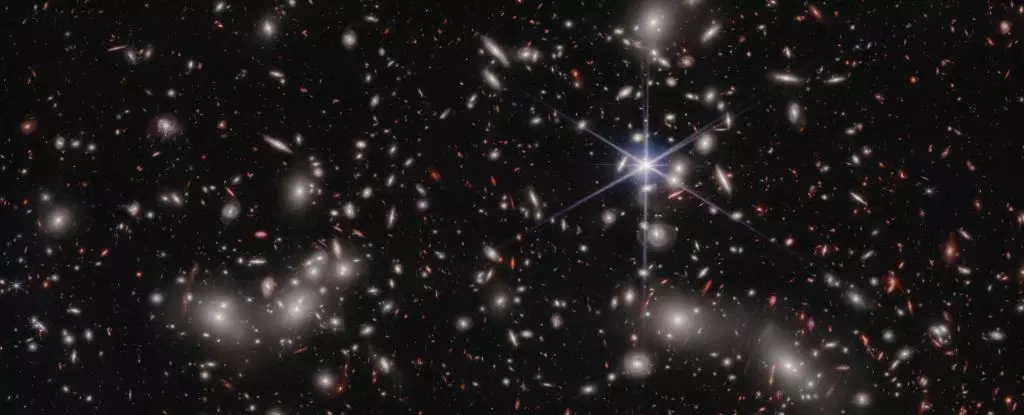The infancy of the Universe, a mere moments after the Big Bang, was characterized by an extreme lack of light—a dark and dense fog of ionized plasma surrounded everything. In this epoch, the initial energies set forth after the Bang had not yet diffused; therefore, the Universe was opaque, and only over time, with cooling and cosmic expansion, did conditions become ripe for the transition from darkness to illumination. Researchers and astrophysicists have relentlessly pursued the mystery behind this transition, especially focusing on cosmic reionization—an event marking the end of the dark ages of the Universe. Recent studies drawn from data provided by the Hubble Space Telescope along with the newer James Webb Space Telescope (JWST) have now shed significant light on the pivotal role small dwarf galaxies played during this extraordinary epoch.
An important revelation has emerged from a collaborative research effort led by astrophysicist Hakim Atek of the Institut d’Astrophysique de Paris. By honing in on a galaxy cluster named Abell 2744, scientists initiated a deep-dive exploration of early galactic structures. Utilizing the gravitational lensing effect created by the sheer density of this cluster, researchers have been able to magnify distant light emanating from tiny dwarfs near the cosmic dawn. This process allowed for detailed spectroscopy, revealing not just the presence of these small galaxies but also their surprising brightness and abundance in the Universe’s formative years.
In contrast to traditional models that assumed more substantial galaxies—or even supermassive black holes—sprouted the bulk of this energetic action, findings indicate dwarf galaxies account for the lion’s share. Truly, the research unveils that these “ ultra-faint” galaxies outnumber larger galaxies by an astonishing ratio of 100 to 1. This new paradigm suggests that understanding low-mass galaxies is pivotal in refining our comprehension of cosmic history.
Dwarf galaxies may be small in stature, but they pose as mighty producers of ionizing radiation—energy strong enough to strip electrons from hydrogen atoms, a process essential for cosmic reionization. This finding not only contradicts earlier expectations but also heightens intrigue in how these minute structures wielded influence over a vast expanse of the Universe. Iryna Chemerynska, an astrophysicist involved in the study, remarked on their immense role in the cosmic narrative, insisting that these low-mass galaxies are crucial players in shaping the current state of the Universe.
A prominent revelation from Atek and his team suggests that the total ionizing radiation output from dwarf galaxies is nearly four times greater than what is typically associated with much larger galaxies. This degree of energetic contribution is far greater than previously understood and underscores the need to rethink the dynamics of galaxy formation and evolution.
While these findings bring clarity to the enigmatic process of reionization, scientists are keen to stress caution and the necessity for additional inquiry. Relying on observations from a singular patch of sky offers only a limited perspective, and researchers are actively pursuing more such lens regions to ensure that their results are neither a coincidence nor an isolated anomaly. The road ahead is illuminated with exciting potential, as a broader view promises to corroborate or refine current understandings of the epoch.
As scientists have basked in the glow of advancing technologies like the JWST, they realize they stand on the precipice of significant discovery. The ability to delve deeper into previously obscured domains could revolutionize our understanding of cosmic evolution. The push to map more dwarf galaxies and their characteristics may alter the current narrative—expanding humanity’s grasp of the Universe.
The revelations regarding dwarf galaxies and their untold contributions to cosmic reionization stands as a monumental leap in our understanding of the Universe’s early stages. In a landscape saturated with grand theories surrounding massive entities like black holes and large galaxies, the spotlight’s sudden shift to small dwarf galaxies challenges prior assumptions and paints an ever-complex tapestry of cosmic history.
As the JWST continues to unlock the secrets of the early Universe, one cannot help but feel a sense of wonder. Each discovery begets new questions, inviting curiosity and enkindling the human spirit to explore. The journey of unveiling the many phases of the Universe’s evolution may just be beginning, yet one thing stands clear: dwarf galaxies may hold the keys to lighting the way through the ever-elusive cosmic darkness.

